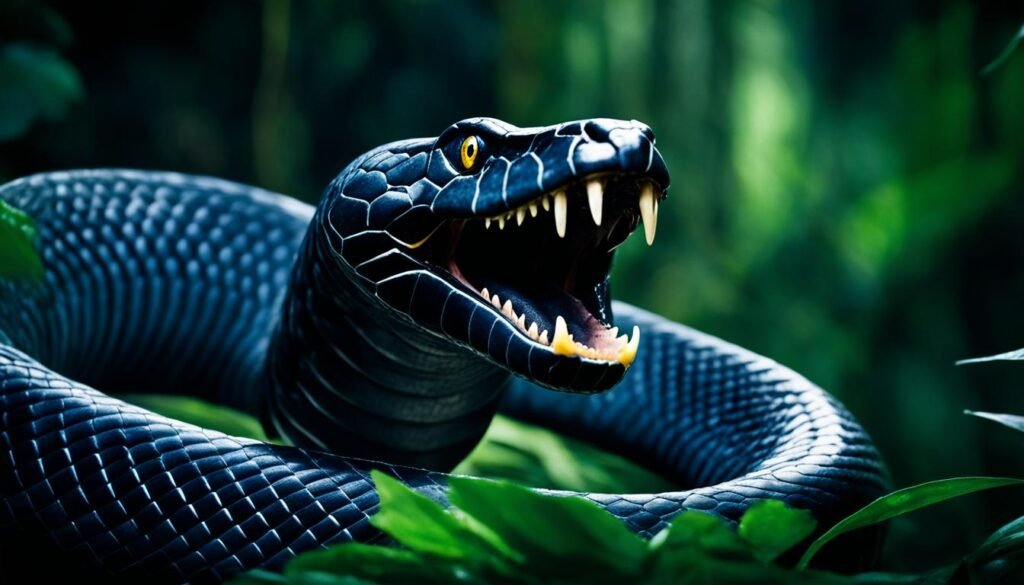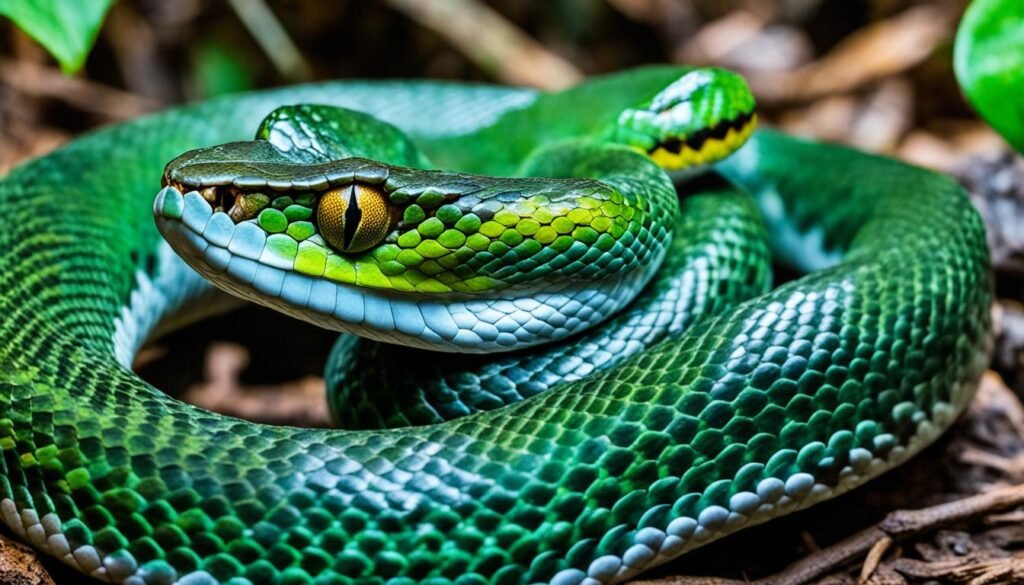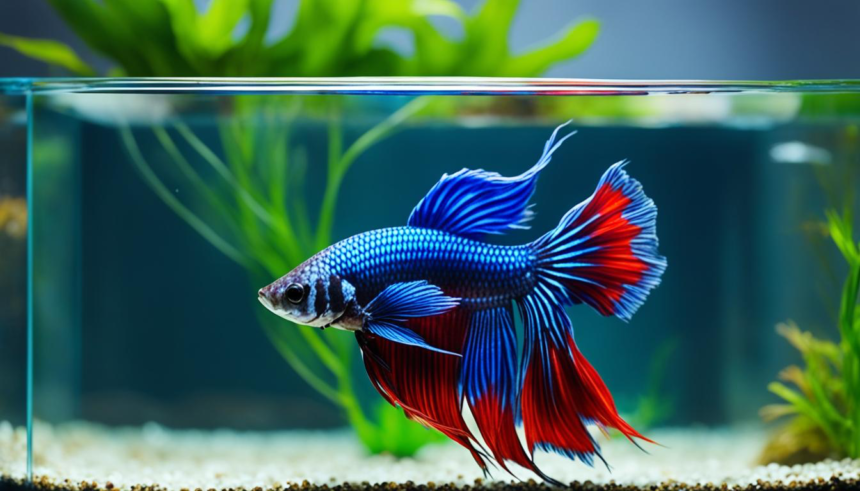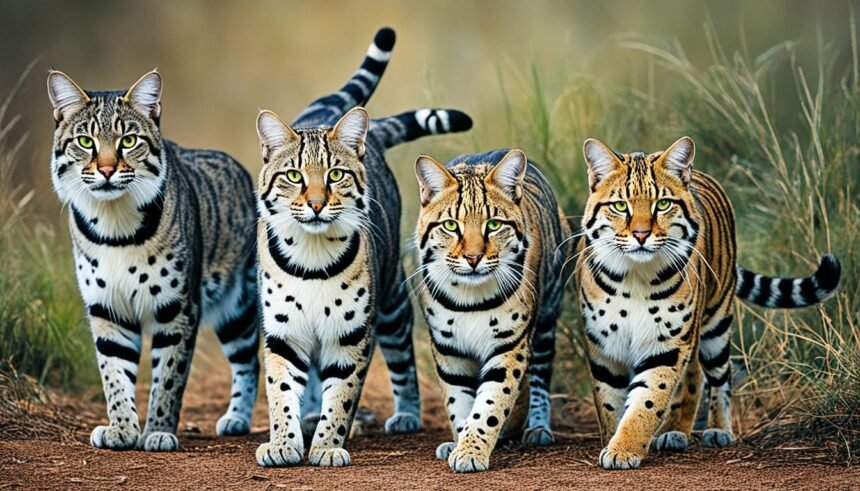Nature’s predators fascinate and scare us, especially the most dangerous snakes. With their deadly venom, these snakes threaten wildlife and people. The saw-scaled viper, for instance, causes more human deaths than any other snake. This fact highlights how deadly these creatures can be.
The coastal taipan and king cobra’s venom is fatal in many cases if not treated. These snakes show how evolution has made them incredibly deadly. Every year, venomous snakes bite 5.4 million people. Thousands die from their venom, which has dangerous toxins like phospholipases.
We’re diving deep into the world of the most dangerous snakes. They are the ultimate survivors in the reptile world. These venomous snakes deserve our respect. We must understand their role in nature and the danger they pose to us.
The Lethal and Elusive Nature of Venomous Snakes
Venomous snakes are masters of disguise and deadly hunters. They fit perfectly into their worlds. This makes them both amazing and scary. Their power to hide and then strike is part of what makes them top predators. We need to learn more about these snakes.
The Cottonmouth or water moccasin varies in size from two to four feet. Females are usually smaller. These snakes focus on having babies to survive. They can have 5 to 10 young ones, but sometimes more. On the other hand, Texas coral snakes lay eggs instead. Baby coral snakes are about seven inches long when they hatch, already having venom.
Timber rattlesnakes can grow to three to five feet and also have babies, not eggs. Their babies come every two to three years. They can have a big family of 5 to 20 young ones. This shows how they keep living and growing in number.
- Copperheads can grow over three feet and have about five babies in the fall. They are dangerous, but bites rarely kill. Still, they need quick medical help if they bite.
- Then, there’s the Eastern Diamondback Rattlesnake. It’s the heaviest venomous snake and can get very long, up to almost 8 feet.
Venomous snakes can be a big health risk. For instance, the bite from a Diamondback can be fatal in 20% to 30% of cases. These snakes are big and strong, showing how venomous snakes can thrive. Their bites also show the impact on ecosystems and health.
But there’s hope because of science. Researchers are learning more about snake venom. They are using new technology to make better antivenoms. This could mean faster treatments for snake bites in the future.
Learning about these scientific steps helps us handle the dangers of snakes better. It’s about respecting these snakes and staying safe. With each discovery, we’re finding ways to live safely with these remarkable but deadly creatures.
Understanding Snake Venom and Its Deadly Components

The power of snake venom has both scared and interested people for a long time. When we talk about snake venom, its deadly components, and their effects, we’re diving into a world of natural selection and survival. Many venomous species are known for their potent venoms, which are key to their survival.
The Evolution of Snake Venom
Snake venom has evolved over millions of years. This evolution boosts their hunting ability and their chances of surviving as prey. Venom became crucial for their survival in nature. The journey of venom evolution shows the ongoing battle between snakes and their environment, including humans.
Deadly Components in a Snake’s Venom
Snake venom is a complex mix designed to capture prey or fend off predators. Some snakes have improved their venom to attack certain prey. For example, the black mamba’s neurotoxins attack the nervous system. Viper venoms have enzymes that break down tissue at the bite area.
How Venom Affects Human Physiology
A snake’s bite can have severe results for a person. The bite can cause local tissue damage or more severe issues like blood problems from haemotoxic venom, or paralysis from neurotoxic venom. Each case shows how a snake’s venom and our bodies interact, highlighting the importance of quick medical help and antivenom.
Snake venom comes from complex evolutionary changes, leading to death or medical breakthroughs. Studying these venomous species pushes us to uncover more about these fascinating natural secrets.
The Black Mamba: Africa’s Formidable Assassin

The black mamba is fast and its venom is deadly. It’s feared throughout Africa. But, knowing how it behaves and where it lives helps us. This knowledge improves our survival chances and supports conservation work.
Facts About the Black Mamba’s Habitat
Black mambas live in many places including savannas and rocky hills in sub-Saharan Africa. They can adapt to living in trees or on the ground. Their camouflaging skills help them hunt and stay hidden from predators.
The Speed and Venom Potency of Black Mambas
Black mambas have very powerful venom, making them top predators. Their venom can cause human collapse in 45 minutes. They move up to 12 miles per hour and get aggressive if trapped. This makes them extremely dangerous.
Survival Rates Following a Black Mamba Bite
If a black mamba bites you, getting antivenom fast is vital. Without it, almost everyone dies. Quick treatment is key because the venom attacks the respiratory system fast. More antivenom is available now, but it’s hard to get in rural Africa.
Understanding the black mamba helps lower deaths and increases respect for this snake. Education is key to live alongside Africa’s deadly assassin safely.
The Infamous Fer-de-Lance: A Pit Viper’s Deadly Strike

The Fer-de-Lance is a top venomous snake. It’s feared in Central and South America for its deadly venom. Adults can be between 1.2 to 2 meters long.
The Fer-de-Lance is part of the Viperid snakes. They cause many severe snakebite injuries each year. Their bites can lead to serious lung problems.
These bites can even cause death. It’s clear the Fer-de-Lance’s bite is extremely dangerous. It can make lungs bleed inside.
Let’s look at how these snakes compare:
| Snake Species | Typical Length | Notable Clinical Effects |
|---|---|---|
| Fer-de-Lance | 1.2 to 2 meters | Envenomation-induced lung injury |
| Okinawa Habu | 1.5 meters | Disability or death |
| Jararaca | 1.2 meters | Significant fatalities in Brazil |
| Jumping Viper | 60 cm | Lesser documented but potent venom |
Studies show the dangers of pit viper venom. An enzyme in the venom causes swelling and inflammation in the lungs. Research on animals shows venom can cause lung damage.
In humans, venom can cause severe lung problems. Reports from Sri Lanka have shown how dangerous a snakebite can be.
The Fer-de-Lance is a very deadly snake. Its strike shows the risk of venomous snakes. We must be careful and prepared in areas where these snakes live.
Boomslang: The Discreet Yet Deadly African Snake

The Boomslang is known for its strong venom and being hard to spot. This snake blends in well with the trees in sub-Saharan Africa. It hunts quietly, making it dangerous to those who cross its path.
Identifying Features of the Boomslang
This snake has big eyes and a thin body, helping it hide among the leaves. It can be green or brown, making it hard to see. The Boomslang is very good at surprise attacks, making it a dangerous predator.
The Unique Hunting Strategy of the Boomslang
The Boomslang waits patiently before it attacks. It strikes quickly, injecting venom that stops blood from clotting. This tactic shows the Boomslang is not only smart but also a top predator in its home.
Medical Consequences of a Boomslang Encounter
Being bitten by a Boomslang needs fast medical help. The venom can cause serious bleeding and damage to the nervous system. Sadly, the right antivenoms are rare and expensive.
Getting effective antivenom is a big issue. It’s vital to have local antivenom production and testing. This could lower the risks from Boomslang bites, which are often deadly in sub-Saharan Africa.
Dangerous snakes, the most dangerous snakes in the world, venomous snakes
Talking about dangerous snakes brings up thoughts of fear and danger. Around 600 venomous snake types are known worldwide. Among them, some are known for their deadly venom, which can paralyze and destroy tissue.
The inland taipan from Australia tops the list of deadly serpents. It has the most toxic venom ever recorded. Knowing about its venom is key to understanding the risk these snakes pose. The eastern brown snake and the western Australian tiger snake also have very toxic venom.
Although Australian snakes are extremely venomous, they’re not the biggest threat to humans. In places like the Indian subcontinent, snakes like the common krait, Russell’s viper, and others are more dangerous. They live close to many people, leading to more bites.
In the United States, and specifically in South Carolina, venomous snakes are common but bites are rare. Snake species here vary in size. The smallest, the pigmy rattlesnake, is about a foot long. The largest, the eastern diamondback rattlesnakes, can grow up to 5 feet. Still, falling down is a more common danger than snakebites.
- Inland Taipan: With a subcutaneous LD50 of merely 0.01 mg/kg, it’s unsurprisingly regarded as the snake with the deadliest venom on the planet.
- Eastern Brown Snake: A close contender in the toxicity race, with a subcutaneous LD50 of 0.041 mg/kg, it’s a species notorious for its aggression and speed.
- Western Australian Tiger Snake: Sporting a subcutaneous LD50 of 0.124 mg/kg, it further underscores Australia’s reputation for harboring some of the world’s most venomous snakes.
- Belcher’s Sea Snake: Often mixed up with the hook-nosed myth, it is nevertheless highly venomous with an intramuscular LD50 of 0.24 mg/kg.
- Black-Banded Sea Krait: Preferring the coastline of the Malay Peninsula and Indonesia, this snake’s intravenous LD50 of 0.111 mg/kg signals a potent venom.
We study dangerous snakes with both respect and caution. Learning about them helps raise awareness, promote safety, and prepare medically.
Unveiling the Mystique of the Eastern Tiger Snake
The Eastern Tiger Snake is part of Australia’s diverse wildlife. It shows how animals have evolved and adapted. These snakes are known for their unique patterns and colors. Australia is home to more venomous snakes than those that are harmless.
Evolving Patterns and Color Variations of Tiger Snakes
The Eastern Tiger Snake has distinctive markings. These snakes come in different colors. This helps warn off predators and lets them hide in nature. Every snake’s look shows its genes and living conditions.
The Eastern Tiger Snake’s Venom and Its Quick Impact
The Eastern Tiger Snake’s venom is very powerful. It acts fast on the nervous system. For people bitten, this can be deadly. Around 421,000 people are bitten by snakes worldwide each year. Fast treatment with antivenom is key, especially in Australia.
Antivenom: A Race Against Time
Creating antivenom is urgent. Horses are used to make it. They’re given small amounts of venom until they make antibodies. This antivenom is vital for treating tiger snake bites. It must be given quickly to help with the venom’s effects.
| Species | Regions Most Affected | Antivenom Availability | Estimated Envenomations per Year | Estimated Annual Deaths |
|---|---|---|---|---|
| Eastern Tiger Snake | Australia | Widely Available | Data Not Specific | Data Not Specific |
| Red-tailed Bamboo Pit Viper | Southeast Asia | Limited | Included in Global Figures | Included in Global Figures |
| Other Venomous Species | South Asia, Southeast Asia, Sub-Saharan Africa | Varies | 421,000 | 20,000 |
Russell’s Viper: Accounting for Most Snakebite Deaths in India
Russell’s Viper causes many snakebite deaths in India. It’s part of the cultural and ecological fabric of the region. Understanding its impact on health is crucial.
The Lethal Nature of Russell’s Viper Envenomation
Russell’s Viper’s bite is a big threat in India. It causes many severe health problems.
Antivenom is key but hard to find. The venom leads to bleeding, tissue death, and organ failure. Quick and effective treatment is vital.
Habitats and Behaviors Contributing to High Risk
Densely populated farms increase the risk of meeting Russell’s Viper. These areas help the snake hide and attack. Encounters with humans become more common, raising the chance of deadly bites.
The Big Four: India’s Most Deadly Snakes and Antivenom Solutions
Russell’s Viper is one of the ‘Big Four’ snakes, known for causing deaths. We must focus on making more antivenom. Protecting certain areas can also lower snake-human conflicts and deaths.
| Country | Annual Snakebite Incidence | Fatalities | Antivenom Production |
|---|---|---|---|
| India | Estimated at 2.7 million envenomings | Approximately 50,000 | World’s largest antivenom producer |
| Colombia | About 5,000 bites | 20 to 40 | Declined to one source, 10,000 to 20,000 vials per year |
| Sri Lanka | Approximately 60,000 bites | About 200 | Heavy reliance on imports from India |
| U.S.A. | 7,000 to 8,000 bites | Approximately 5 | N/A |
The table shows the serious snakebite problem worldwide. India plays a huge role in making antivenom. By 2030, the WHO wants to cut death rates in half. Managing Russell’s Viper and other dangerous snakes is key.
Saw-Scaled Viper’s Aggressive Reputation and Lethal Bites
The Saw-Scaled Viper is known for its aggressive reputation and lethal bites. This viper’s behavior needs to be understood because of the danger it poses. In places where they are common, the Saw-Scaled Viper causes many snakebite cases. These often lead to serious health issues or death.
Snakebites are a big health problem worldwide. In places like India, they are deadly and a major public health issue. Bites from a Saw-Scaled Viper can cause severe health problems. These range from hypopituitarism to acute renal failure and even heart attacks. Quick and correct medical treatment is crucial after being bitten.
Sometimes, snakebites can cause unusual symptoms. These include fast heartbeats and swelling of the salivary glands. The variety in symptoms makes it hard to diagnose and treat. Also, some people develop capillary leak syndrome after a bite. This shows the seriousness of the viper’s venom and the need for various medical skills in treating it.
When it comes to treatment, research has looked at different anti-venom doses. It’s vital to use the most effective treatment right away. The right dose can save lives by countering the lethal bites of the Saw-Scaled Viper.
In conclusion, the Saw-Scaled Viper’s aggressive reputation and lethal bites are real threats. Knowing how to prevent bites, researching anti-venom treatments, and having prepared medical teams are key. These steps are crucial for reducing risks from this dangerous snake.
The Fear-Inducing Inland Taipan: A Toxic Snake Rarely Seen
The Inland Taipan is the most toxic snake on the planet. It is known for its powerful venom and hidden lifestyle.
The Inland Taipan’s Venom: The World’s Most Toxic
The Inland Taipan’s venom is unmatched in its ability to quickly take down prey. Its venom, from the Oxyuranus genus, combines paralyzing and clotting effects. Among 700 venomous snakes with front fangs, its venom works the fastest. This makes it very dangerous, even though human bites are rare.
Isolation and Elusiveness: Why the Inland Taipan is Rarely Encountered
This snake lives in the remote deserts of central Australia. The areas are so empty, seeing it is uncommon. The Inland Taipan hides well and lives alone. It prefers underground homes, which makes it hard to find.
Surviving an Inland Taipan Bite: Antivenom and Medical Response
Though Inland Taipan bites are rare, they need quick medical attention. Antivenom is vital for survival. Out of over 3,400 snake species, less than 300 are venomous. Dealing with an Inland Taipan bite needs a special kind of antivenom. But giving antivenom can sometimes cause allergies. This shows how complicated treatment can be.
| Species | Venom Type | Global Annual Snakebite Mortality | Antivenom Availability |
|---|---|---|---|
| Inland Taipan | Neurotoxic | – | Monovalent |
| Other Elapids | Neurotoxic/Haemotoxic | 80,000–140,000 | Polyvalent |
| Vipers | Haemotoxic | – | Polyvalent |
| Boomslang | Hemotoxic due to SVMPs | – | Polyvalent |
| Colubridae Family | Variable; Often Less Toxic | – | Monovalent/Polyvalent (if available) |
Understanding the Inland Taipan requires knowing its home, venom strength, and the needed medical care. Its hidden lifestyle avoids people, but a bite is serious. This shows why having antivenom and knowing how to use it is important.
Conclusion
Exploring venomous snakes reveals their significant impact on human health. In Colombia, about 5,000 people are bitten by snakes yearly, leading to 40 deaths. This shows the severity of the threat these animals pose. Globally, the situation is even direr, with thousands suffering from snakebite-related deaths and lifelong injuries. This highlights the real danger these creatures represent worldwide.
Snake venom poses a huge risk, particularly in India and Pakistan where over 75% of snakebite deaths occur. Many snakebite cases might not even be reported. This could make the problem seem less severe than it truly is. The World Health Organization aims to reduce deaths and injuries from snakebites by half by 2030. This highlights the urgent need for better access to antivenoms and for public health and education efforts to be stepped up.
The challenge of snakebites demands practical responses, like making more antivenoms. Sri Lanka’s partnership with the U.S. and Costa Rica on antivenom is a step in the right direction. This approach should be supported and copied elsewhere. Even though snakes like Lachesis muta in Alto Juruá are not the most common, their bites can still lead to many deaths and amputations. As we continue to combat the deadliest snakes, our global and community response must grow stronger. This is essential for advancing global healthcare and community safety.
FAQ
What are the top 5 most dangerous and venomous snakes worldwide?
The top 5 most dangerous and venomous snakes include the black mamba, the fer-de-lance, the boomslang, the Eastern tiger snake, and Russell’s Viper.
What makes venomous snakes so lethal and elusive?
Venomous snakes are tough to spot because they blend into their surroundings. They have deadly bites that can make you very sick.
What is snake venom and what are its deadly components?
Snake venom is made of different toxins, which vary by snake species. These can be neurotoxins, hemotoxins, and cytotoxins. They affect the body in deadly ways, causing paralysis, organ failure, or death.
What are the characteristics of the black mamba and why are its bites so deadly?
The black mamba is fast and extremely deadly, found in Africa. Its venom is so strong that it can quickly overpower its prey. Black mamba bites can stop you from breathing or cause death.
What is the fer-de-lance and why is its strike so deadly?
The fer-de-lance, a dangerous pit viper, is known for its lethal bite. Its venom causes serious tissue damage. Being bitten can lead to terrible pain, swelling, and sometimes losing a limb.
What are the identifying features and hunting strategies of the boomslang?
The boomslang is a sneaky African snake with a slender body, big eyes, and distinctive colors. It hides perfectly in its environment to surprise and bite its prey.
What should I do if I encounter a venomous snake?
If you meet a venomous snake, stay cool and back away slowly. Never try to touch or upset the snake. If you get bitten, get help immediately.
How can I protect myself from venomous snake bites?
To stay safe from snake bites, be careful and steer clear of snake areas like the country or snake-packed spots. Wearing boots and long pants adds extra safety.
What is the most venomous snake in the world?
The inland taipan, known as the “fierce snake,” tops the list as the most venomous. Its bite is super toxic and could kill you fast if not treated.
Are all snakes venomous?
No, not every snake is venomous. Actually, most snake kinds are safe and not harmful to people.













